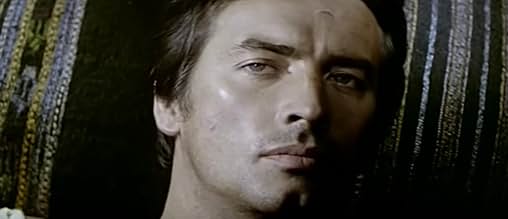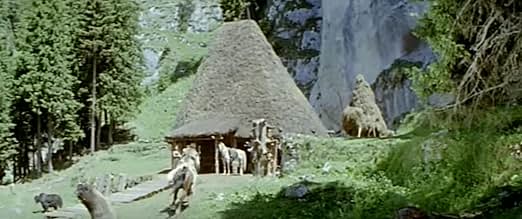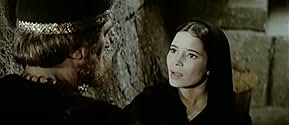NOTE IMDb
7,6/10
2,1 k
MA NOTE
Ajouter une intrigue dans votre langueThe Dacian kingdom lies at the eastern border of the Roman Empire.Only the river Danube separates the two mortal enemies.The Dacian king Decebalus knows that soon the vastly superior Roman l... Tout lireThe Dacian kingdom lies at the eastern border of the Roman Empire.Only the river Danube separates the two mortal enemies.The Dacian king Decebalus knows that soon the vastly superior Roman legions will cross the river and attack Dacia.The Dacian kingdom lies at the eastern border of the Roman Empire.Only the river Danube separates the two mortal enemies.The Dacian king Decebalus knows that soon the vastly superior Roman legions will cross the river and attack Dacia.
- Réalisation
- Scénario
- Casting principal
Avis à la une
Attractive Romanian film (actually a Romanian-French co production filmed in Romania) belonging to the swords and sandals genre and telling the story of how the Dacians confronted and resisted the Roman Empire at around 100 AD. Great action scenes, attractive outdoor locations (in pastoral like locations) are a plus. This was made in 1967, when many films of this sort were made in the West (the so called Peplum, including Spartacus, Cleopatra and countless Italian movies), yet this particular film seems to be little known outside Romania. It is a well made, entertaining film with fine color photography. Since the Dacians are believed to be the ancestors of the Romanians, I suppose part of the purpose of the film was to raise nationalist consciousness, but this is thankfully not too heavy.
The newspaper "Adevarul" (the Truth) releases on DVD the "Historical" series of movies made by Sergiu Nicolaescu in the '60s, '70s and '80s. This contains the movies "Dacii" (the dacians), "Mircea", "Mihai Viteazul", "Nemuritorii" (the Imortals), "Capcana mercenarilor" (the mercenaries' trap), "Pentru patrie" (for the country). They are restored from film rolls from the National Film Archive (or national television archive), but quality is limited to VHS resolution. Given the film and audio technology level in 1967 the soundtrack is mono with subtitles in English and french. Colors are restored, but some scratches are visible throughout the movie, given its 41 years of age. Visual or audio effects were no concern for Nicolaescu, since its movies are based on historical facts transcending time and people. Fight scenes are real, using 5000 plus extras synchronized and filmed with multiple cameras, since no more than two takes were possible in one day at that scale. I don't know if the movies will be available outside the country, since are distributed only with the paper. http://www.filmeleadevarul.ro/istorice/category/filme/dacii/
10vic441
Unlike many Hollywood movies of the same period (Cleopatra, Ben-Hur, Fall of the Roman Empire, etc) this one is almost perfect in the historical accuracy sence. They used the latest archeological data available at the time (Trajan's column) to show Roman legions in their glory. Cinematography is great. I've heard they used something like 5,000 extras to create battle scenes. Unlike its sequel (Collona), this movie is a masterpiece for everyone who likes cinema and ancient history. I think that if it would be released in the USA it would be nominated for Oscar. Its a shame that this video is hard to find and is not available in major stores.
A Romanian film – better-known, if at all, by its original title DACII – about the Roman (i.e. Italian) Empire is an absolute rarity, but I was instantly drawn to it from the evocative stills I saw on the Internet. The fact that it featured a couple of French stars in Pierre (MILL OF THE STONE WOMEN {1960}) Brice and Luis Bunuel/peplum regular Georges Marchal, then, was merely the icing on the cake; however, it did feel odd hearing them speak in a completely foreign tongue! For all its obvious naivete' (being, at best, a semi-professional enterprise and actually only the director's first feature-length effort!), the end result proves reasonably impressive – primarily on the visual front (with location photography that is indeed spectacular and the battle sequences themselves emerging as not only surprisingly elaborate but rather brutal as well!).
That said, the plot offers its own interest – with even some novelty value in store: the titular people are engaged in war against the Romans (rulers of all the known world at that time). Being Pagans, to determine whether the odds are in their favor or not, it is required that the King sacrifice his first-born i.e. a son who is literally dumped upon an upturned fork and bleeding to death! This turn-of-events naturally sours the relationship between the potentate and his daughter, who leaves the castle grounds to settle in the country. The Romans, too, have their problems: Emperor Domitien is perhaps the most condescending ever portrayed; his adviser is adamantly against invasion (believing the Dacians can be persuaded to lay down their arms without the need for carnage); their ageing if still athletic champion warrior (Marchal) is suffering from temporary blindness due to an old wound; while another 'star' officer (Brice, actually the afore-mentioned bureaucrat's son) is wounded during an initial skirmish, cured for by the Dacian king's daughter (needless to say, they end up falling in love), and ultimately revealed to be a native of the very land he is intent on conquering for the glory of Rome!
A sort of follow-up, made by other hands, was 1968's COLUMNA aka THE COLUMN which similarly featured 'recognizable' names for the international market (though their overseas exposure was extremely limited in the long run!): Briton Richard Johnson and Italians Antonella Lualdi (from Vittorio Cottafavi's THE HUNDRED HORSEMEN {1964}) and Franco Interlenghi. Actually, THE DACIANS reminded me of Robert Siodmak's two-parter STRUGGLE FOR ROME (1968) – a German epic that was only released abroad in heavily-truncated form as THE LAST ROMAN.
That said, the plot offers its own interest – with even some novelty value in store: the titular people are engaged in war against the Romans (rulers of all the known world at that time). Being Pagans, to determine whether the odds are in their favor or not, it is required that the King sacrifice his first-born i.e. a son who is literally dumped upon an upturned fork and bleeding to death! This turn-of-events naturally sours the relationship between the potentate and his daughter, who leaves the castle grounds to settle in the country. The Romans, too, have their problems: Emperor Domitien is perhaps the most condescending ever portrayed; his adviser is adamantly against invasion (believing the Dacians can be persuaded to lay down their arms without the need for carnage); their ageing if still athletic champion warrior (Marchal) is suffering from temporary blindness due to an old wound; while another 'star' officer (Brice, actually the afore-mentioned bureaucrat's son) is wounded during an initial skirmish, cured for by the Dacian king's daughter (needless to say, they end up falling in love), and ultimately revealed to be a native of the very land he is intent on conquering for the glory of Rome!
A sort of follow-up, made by other hands, was 1968's COLUMNA aka THE COLUMN which similarly featured 'recognizable' names for the international market (though their overseas exposure was extremely limited in the long run!): Briton Richard Johnson and Italians Antonella Lualdi (from Vittorio Cottafavi's THE HUNDRED HORSEMEN {1964}) and Franco Interlenghi. Actually, THE DACIANS reminded me of Robert Siodmak's two-parter STRUGGLE FOR ROME (1968) – a German epic that was only released abroad in heavily-truncated form as THE LAST ROMAN.
"The Dacians" (Dacii) follows a very decent plot for a sword-and-sandal genre. Roman legions invade Dacia ready to become "The Masters of the World." But this Roman world is not united, but filled with intrigues and back stabbing among the Emperor and the general. "Sufro," (I suffer it) proclaims the Emperor while hiding his satisfaction. On the Dacian side, patriotism (300 Spartans style) fills their souls. "Why the Dacian smile when they die?" asks the Roman commander.
The photography of the Romanian country side and the Roman Legions on the march is excellent. The soundtrack is superb when the Roman legions are advancing. To add to the spectacle 5,000 extras fill the landscape.
Thanks to a Web site that sells Romanian movies in the NTSC format, I could watch this little jewel again. The follow up ("Column" or "The Trajan Column")seems to be unavailable.
The photography of the Romanian country side and the Roman Legions on the march is excellent. The soundtrack is superb when the Roman legions are advancing. To add to the spectacle 5,000 extras fill the landscape.
Thanks to a Web site that sells Romanian movies in the NTSC format, I could watch this little jewel again. The follow up ("Column" or "The Trajan Column")seems to be unavailable.
Le saviez-vous
- AnecdotesThe Dacian costumes were hard to create. Director Sergiu Nicolaescu had to travel to Rome where he studied the Dacian costumes featured on Trajan's Column. The costumes were created by Romanian costume designer Hortensia Georgescu.
- GaffesIn some scenes, watches are visible on the wrists of Roman and Dacian soldiers.
- ConnexionsReferenced in Frissons teutons - Les Films Edgar Wallace (2011)
Meilleurs choix
Connectez-vous pour évaluer et suivre la liste de favoris afin de recevoir des recommandations personnalisées
- How long is The Dacians?Alimenté par Alexa
Détails
Box-office
- Budget
- 20 113 000 ROL (estimé)
- Durée1 heure 50 minutes
- Mixage
- Rapport de forme
- 2.35 : 1
Contribuer à cette page
Suggérer une modification ou ajouter du contenu manquant

Lacune principale
By what name was Les Guerriers (1966) officially released in India in English?
Répondre




















